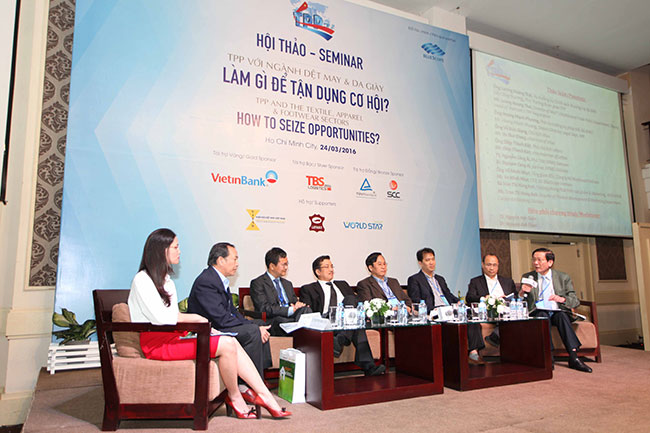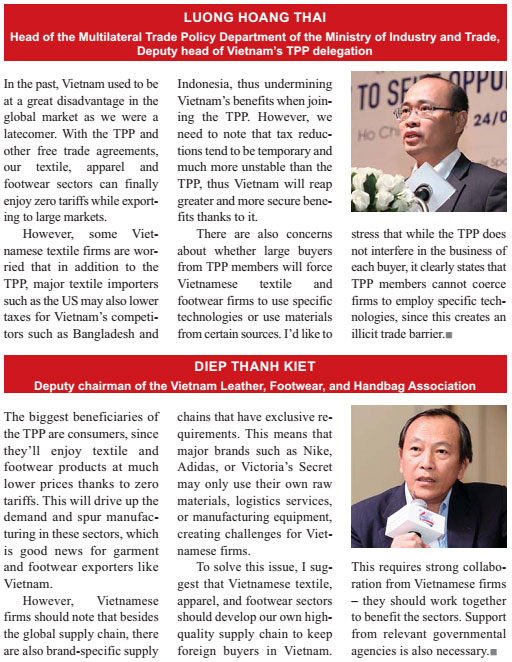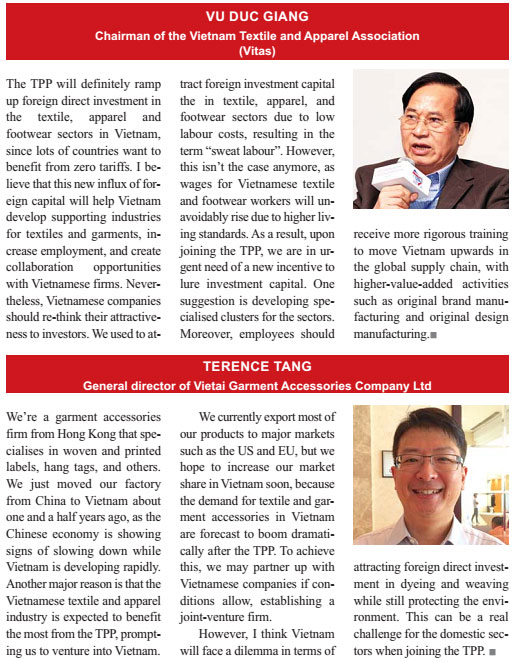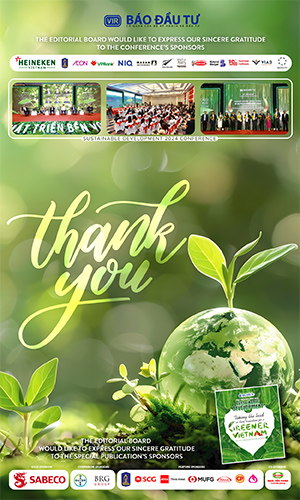FTA benefits dangle by a thread

Last week’s seminar in Ho Chi Minh City helped local textile, apparel, and footwear firms prepare for the TPP
Photo: Le Toan
“Many Vietnamese enterprises are still confused regarding the incoming Trans-Pacific Partnership (TPP), despite the fact that they know they have many disadvantages compared to foreign competitors,” said Nguyen Cong Ai, deputy general director of KPMG Vietnam.
“Opportunity is not equally divided, but the more seriously an enterprise prepares for it, the better results they should have,” Ai told last week’s forum themed “TPP and the Textile, Apparel and Footwear Sectors: How to Seize Opportunities” in Ho Chi Minh City, which was co-organised by VIR and the Vietnam Association of Foreign Invested Enterprises (Vafie).
Moreover, Ai noted, Vietnamese garment, textile, and footwear sectors not only had to struggle with their dependence on foreign materials, increasing labour standards, and new targets in manufacturing capacity, they were also at risk of losing their slice of the market share in Vietnam.
Foreign invested enterprises, meanwhile, have invested a lot into the textile, garment, and footwear sectors in Vietnam in order to seize the TPP’s lucrative trade benefits. Among these are Taiwan’s Far Eastern, Turkey’s Hyosung Dong Nai, Hong Kong’s Lu Thai Yarn, and Worldon from the British Virgin Islands.
Deputy Minister of Planning and Investment Dang Huy Dong highlighted the importance of smooth connectivity between sectors.
Enterprises in related sectors, Dong said, should be concentrated in proximity and have a similar mind-set in terms of their zoning plan in order to reduce costs and increase competitiveness.
“Those enterprises can use services and support each other in an aim to improving the quality and efficiency of the whole value chain,” Dong said.
In the near future, the garment, textile, and footwear sectors will have to create a link between companies in the value chain, giving preferential credit to projects and companies investing in technology, machinery, design capacity, and increasing co-operation with foreign investors to fully grasp the opportunities for increased trade fostered by the TPP.
At present, Vietnam’s textile and garment sector is mostly contractors involved in the “cut-make-trim” process of the global supply chain, and are ultimately unable to carry out the whole process. As such, the added value of Vietnamese products is low. It is estimated that between 60 and 70 per cent of input materials are imported, predominantly from China, South Korea, and Taiwan. Moreover, these sectors are weak in design. As they are mostly subcontractors, they don’t have the ability to design and build their own brands.
International institutions forecast that Vietnam’s textile and garment sector is in a position to achieve $30 billion in the total export value by 2020, increasing to $55 billion by 2025.
However, this can only be achieved if raw material producers post similar growth. In other words, developing supporting industries for the textile and garment sector plays a decisive role, paving the way for businesses in the sector to boost efficiency once the free trade agreements come into force.
 |
 |
| Seminar on the future of Vietnam’s textile and footwear after TPP opens
The seminar on the Trans-Pacific Partnership and the Vietnamese textile, apparel, and footwear sectors has just opened in Ho Chi Minh City. |
What the stars mean:
★ Poor ★ ★ Promising ★★★ Good ★★★★ Very good ★★★★★ Exceptional
Latest News
More News
- Trung Nguyen Legend breaks ground on Southeast Asia’s largest coffee factory in Buon Ma Thuot (March 11, 2025 | 14:51)
- Sandbox for crypto assets in Vietnam: if not now, when? (March 11, 2025 | 11:34)
- Ho Chi Minh City Metro Line 1 officially inaugurated (March 10, 2025 | 14:15)
- FDI inflows rise 35 per cent in first two months (March 07, 2025 | 16:21)
- Sustaining growth in a volatile global environment (March 06, 2025 | 14:00)
- PM holds dialogue with businesses from ASEAN (March 05, 2025 | 08:46)
- Shrinking demand mutes manufacturing growth (March 03, 2025 | 11:15)
- Vietnam welcomes European firms for shared successes: PM (March 03, 2025 | 10:17)
- Ministry of Finance merges with MPI and CMSC (February 28, 2025 | 19:36)
- Cutting red tape to bolster economic growth (February 27, 2025 | 16:58)
















 Mobile Version
Mobile Version